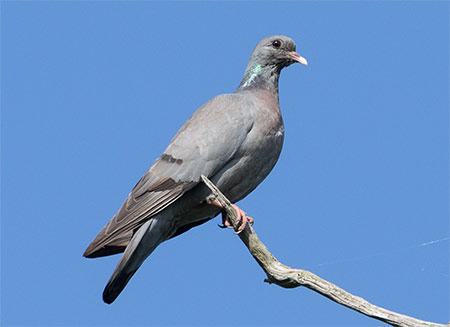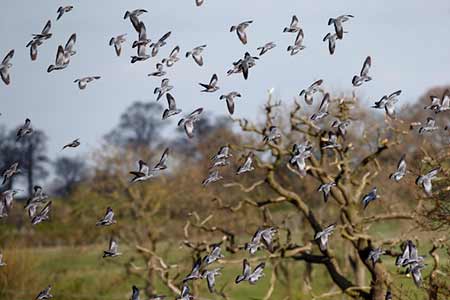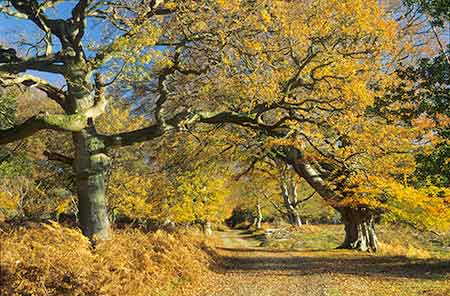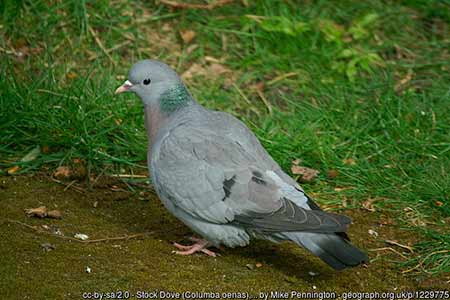Stock Dove (Columba oenas)
(1) Where, when and how many

In the wider countryside, including around the edges of the National Park, they occur on farmland and in parks and gardens, usually where mature deciduous trees are present.
When: Stock Doves are year-round residents although it is likely that at least some birds leave the New Forest woodlands in autumn and winter to search for better feeding places elsewhere - flocks of up to 500 birds are sometimes encountered on farmland at this time and there is also evidence, through visible migration, of non-local movements of significant numbers of birds, particularly in spring, autumn and early winter.
How many: Stock Doves are relatively common and widespread in the New Forest, but their presence is most conspicuous when they are calling.
(In England generally, population numbers have increased significantly since the mid-1960s and continue to rise - a little heralded wildlife success story).

(© Mike Lane / dreamstime.com)
(2) Enigmatic birds of the old woods
Enigmatic is a word that can be used to describe Stock Doves during the breeding season, birds that are frequently heard but not as often seen, partially because they reside for much of the time in the tree tops, and also because relatively few people take the trouble to seek them out.
But most with knowledge of bird sounds are generally aware of their presence for Stock Doves have a distinctive call that carries well through the woods. Often written as a simple 'ooo-oh' or 'ooo-er', these are pretty fair representations. The call is regularly repeated but with a noticeable pause between each repetition. Although sometimes described as gruff, to some extent it is rather soft, soothing, even soporific, a sound particularly noticeable in summer when few other bird sounds can be heard.
To look at, Stock Doves are fairly plain grey birds with a hint of blue in the plumage. Each wing has two short, dark bars, and blackish tips and rear edges. Good views may reveal a little colour in the breast and a glossy green patch on the side of the neck. They are a little smaller than wood pigeons, more compact, even dainty, and lack that bird's white neck and wing markings. They are altogether darker than collared doves, and a little larger and far plainer than turtle doves.
(3) Breeding season behaviour
Stock Doves on the Crown Lands of the New Forest usually site their nests in tree cavities although elsewhere, cliff and quarry faces, and gaps in the brick or stonework of old ruined buildings are also used and so, apparently, are disused rabbit burrows. They will also occasionally nest in the branches of a tree and even on the ground.

Competition for cavities can be fierce - jackdaws, tawny owls and grey squirrels, for example, also make use of these places, and of course, other Stock Doves might try to stake a claim.
Display flights above and between the trees can involve two, or sometimes more, Stock Doves flying in quite wide circles using particularly deep wing beats, indeed so deep that the wings at times clap together over the back.
The nest involves little construction effort for, at most, it comprises a scattering of twigs, grasses or leaves cast casually down onto the floor of the cavity.
Typically, two eggs are laid that, as with the eggs of many cavity nesters, are pure white to help make them more visible to potentially clumsy parents. There are up to four broods annually, normally spanning the period from March until September but sometimes going right the way through into October.
The task of incubation is shared by both parents and lasts for 16 - 18 days, whilst the youngsters - sometimes referred to as squabs - fledge after 20 - 30 days. Both parents care for and feed the young which initially take 'milk' from the lining of the parents' crop, a habit shared with, for example, wood pigeons. Sometimes known as pigeon's milk, this is a milky secretion that the young take by thrusting their bills into the throat of the parent.

(4) Diet
Stock Doves feed mainly on the ground and less frequently in trees, taking a variety of plant material including acorns, beech mast, seeds, green leaves, buds and flowers; and to a far lesser extent, invertebrates.
Particularly where mature trees are present nearby, Stock Doves will also visit garden bird feeding stations, presumably more so in poor mast years and when other natural food is difficult to find in the countryside.
References:
Hampshire Bird Atlas 2007-12: edited by John Eyre
Hampshire Bird Report: 2017 and 2018
Collins Bird Guide: Mullarney, Svensson, ZetterstrÖm and Grant
Handbook of the Birds of Europe, the Middle East and North Africa, The Birds of the Western Palearctic (volumes 1-9): Stanley Cramp, et al
BTO BirdTrends
Quick links
More links
Search this site

